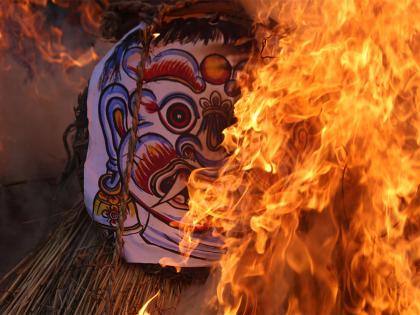Nepal's Kathmandu Valley welcomes festive season burning effigy of demon deity "Ghantakarna"
By ANI | Updated: July 23, 2025 22:59 IST2025-07-23T22:54:25+5:302025-07-23T22:59:29+5:30
By Binod Prasad Adhikari Bhaktapur [Nepal], July 23 : The Newa community of Nepal's Kathmandu valley, from Wednesday, welcomed ...

Nepal's Kathmandu Valley welcomes festive season burning effigy of demon deity "Ghantakarna"
By Binod Prasad Adhikari
Bhaktapur [Nepal], July 23 : The Newa community of Nepal's Kathmandu valley, from Wednesday, welcomed the festive season by burning the effigy of demon deity "Ghantakarna" at the crossroads and dragging it down to the river.
Falling on Trayodashi (third day) of the month of Shrawan (July/August), which is also known as Ghantakarna Chaturdasi, is celebrated in memory of mythical demon Ghantakarna's death.
"Today we are throwing off the evil spirits and the ghosts off our house, if they are taking shelter in. It is dragged down to the river with the help of the rope," Shree Krishna, a resident of Bhaktapur, told ANI.
According to legends, demon Ghantakarna used to terrorise villagers by stealing children and women of the village and demanding money and other gifts as ransom for their release.
His body was painted in red, blue and black, and he wore a pair of bells on his ears. He looked very scary, and every time he moved, the bells jingled. He got his name from the bells on his ears, i.e. Ghanta meaning 'bell' and Karna meaning 'ears'.
The fear of dreadful monsters kept people inside their homes most of the time. Even during the season of plantation, they didn't dare to get out of their home. However, one day, a large number of frogs came to the village and began to croak near Ghantakarna's place.
He became furious, but frogs did not stop. They croaked even louder, and when he tried to catch them, they jumped into the water. He, too, jumped into the water without realising that it was a swamp and soon started to drown. The frogs swarmed around his head, and he died. In this way, the frogs saved the village and the villagers from the demon.
Effigies built in the turnings and roadways of the locality are later dragged and burnt into ashes in areas that lie far from the residential areas, mostly in the crossroads.
This festival is also celebrated as a symbol of cleanliness, and the garbage inside and outside the house is cleaned and disposed of in a systematic manner. This festival is celebrated by cleaning the garbage in the form of a ghost to ward off pests that do not observe sanitation during the planting period, as various insects cause trouble at this time.
"With the marking of Ghantakarna or the Gathemangal Charhe, Goddess Nawa Durga, Ganesh and Mahadev are believed to have risen back for protection. The Newa communities' festive season has formally begun from today," Ram Prasad Bakhunche, another resident of Bhaktapur, told ANI.
On the day of Gathemangal, a person is appointed as a symbol of the offspring of a demon named Ghantakarna and asked to pay for his deeds. It is customary to drive out ghosts by burning torches day and night. In the evening, the idol of Ghantakarna is dragged to a nearby river and burnt. It is customary to put a three-legged or five-legged fortified iron, brass or copper ring on the doorstep of the house after the bell has rung.
Disclaimer: This post has been auto-published from an agency feed without any modifications to the text and has not been reviewed by an editor
Open in app


